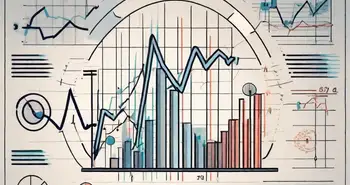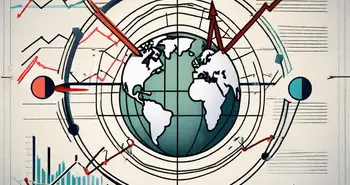A Comprehensive Guide on How to Get Into Trading

Trading can seem like a daunting world to enter, but with the right knowledge and skills, anyone can become a successful trader. In this comprehensive guide, I will walk you through the basics of trading, essential skills you need to develop, setting up your trading account, and how to develop a profitable trading strategy.
Understanding the Basics of Trading
Before diving into the world of trading, it's important to understand what it is and how it works. Trading is the buying and selling of financial instruments such as stocks, currencies, or commodities with the aim of making a profit. It involves analyzing market trends, economic indicators, and taking calculated risks.
Trading is a dynamic process that requires knowledge, analysis, and decision-making skills. As a trader, you aim to predict the future direction of prices and take advantage of market movements. This can be done by analyzing charts, studying financial statements, and keeping up to date with news and events that may impact the markets.
There are various styles of trading, each with its own unique characteristics. Day trading involves buying and selling financial instruments within the same trading day, taking advantage of short-term price fluctuations. Swing trading involves holding positions for a few days to a few weeks to capture larger price movements. Position trading, on the other hand, involves holding positions for several months or even years, based on long-term trends.
Financial markets play a crucial role in trading as they provide a platform for the buying and selling of financial instruments. Whether it's the stock market, forex market, or commodities market, understanding how these markets function is vital. Factors such as supply and demand, economic indicators, and geopolitical events can all impact market prices.
When it comes to trading stocks, investors often look for companies that have strong financials, a competitive advantage, and a solid growth strategy. They analyze financial statements, such as income statements, balance sheets, and cash flow statements, to assess the company's financial health and potential for growth. Additionally, they consider factors such as industry trends, competitive landscape, and regulatory environment to make informed investment decisions.
In the forex market, traders focus on currency pairs and their exchange rates. They analyze economic indicators, such as GDP growth, inflation rates, and interest rates, to determine the strength or weakness of a country's economy. They also monitor geopolitical events, such as political instability or trade disputes, which can have a significant impact on currency values.
Commodity trading involves buying and selling physical goods, such as oil, gold, or agricultural products. Traders analyze supply and demand factors, such as weather conditions, production levels, and global demand, to predict price movements. They also consider geopolitical factors, such as conflicts or trade agreements, which can affect the supply and demand dynamics of commodities.
Successful trading requires a combination of technical analysis and fundamental analysis. Technical analysis involves studying price charts, patterns, and indicators to identify potential entry and exit points. Fundamental analysis, on the other hand, involves evaluating the intrinsic value of a financial instrument based on its underlying factors, such as earnings, growth prospects, and market conditions.
In conclusion, trading is a dynamic and complex process that involves analyzing market trends, economic indicators, and taking calculated risks. Understanding the different types of trading, such as day, swing, and position trading, is essential for developing a trading strategy. Additionally, having a deep understanding of financial markets and the factors that influence them is crucial for making informed trading decisions.
Essential Skills for Successful Trading
To succeed as a trader, you need to develop certain skills that will help you navigate the market with confidence. Let's delve deeper into these skills and explore how they can contribute to your trading success.
Analytical Skills: Reading and Interpreting Charts
Analyzing charts is an essential skill in trading. By studying price patterns, trends, and indicators, you can identify potential entry and exit points. Technical analysis is a valuable tool in understanding market sentiment and making informed trading decisions.
When analyzing charts, it's important to consider various factors such as support and resistance levels, moving averages, and volume. These indicators provide valuable insights into market dynamics and can help you spot opportunities that others may overlook.
Furthermore, understanding different chart patterns, such as head and shoulders, double tops, and triangles, can give you an edge in predicting future price movements. By recognizing these patterns, you can anticipate potential breakouts or reversals and adjust your trading strategy accordingly.
Risk Management: How to Protect Your Investments
Risk management is crucial in trading to preserve capital and minimize losses. This involves setting stop-loss orders, diversifying your portfolio, and implementing a risk-reward ratio for each trade.
Setting stop-loss orders is a fundamental aspect of risk management. By defining a predetermined point at which you will exit a trade if it goes against you, you can limit your potential losses. This not only protects your capital but also helps you maintain a disciplined approach to trading.
Diversifying your portfolio is another key component of risk management. By spreading your investments across different asset classes, sectors, and geographical regions, you can reduce the impact of any single investment on your overall portfolio. This diversification strategy helps mitigate the risk of significant losses in case one particular investment performs poorly.
Implementing a risk-reward ratio is essential for maintaining a balanced approach to trading. By determining the potential reward in relation to the risk taken for each trade, you can ensure that your potential profits outweigh your potential losses. This ratio helps you assess whether a trade is worth pursuing and allows you to make informed decisions based on calculated risks.
Emotional Control: The Psychology of Trading
Emotional control is often overlooked but is equally important in trading. Greed, fear, and impatience can cloud your judgment and lead to poor decision-making.
Developing discipline is a crucial aspect of emotional control. This involves sticking to your trading plan, following your predetermined strategies, and not succumbing to impulsive actions based on emotions. By maintaining discipline, you can avoid chasing after quick profits or making rash decisions that could jeopardize your trading success.
Staying grounded is another vital element of emotional control. The market can be volatile, and it's easy to get caught up in the excitement or panic of rapid price movements. However, by staying calm and rational, you can make objective decisions based on analysis rather than emotions.
Lastly, sticking to your trading plan is essential for maintaining emotional control. A well-defined trading plan outlines your strategies, risk tolerance, and goals. By adhering to this plan, you can avoid impulsive trades driven by emotions and stay focused on your long-term objectives.
In conclusion, developing essential skills such as analytical skills, risk management, and emotional control is crucial for successful trading. By honing these skills, you can navigate the market with confidence, make informed decisions, and increase your chances of achieving long-term profitability.
Setting Up Your Trading Account
Before you start trading, you need to set up a trading account. Here are the key steps to get started.
Choosing the Right Trading Platform
The trading platform you choose will be your gateway to the financial markets. Look for a platform that offers a user-friendly interface, advanced charting tools, real-time market data, and reliable execution. Take advantage of demo accounts to test different platforms before making a decision.
Understanding Brokerage Accounts
A brokerage account is where you hold your funds and execute trades. Research different brokerage firms and consider factors such as fees, customer support, and the range of financial instruments available. Opening a brokerage account requires completing an application, providing identification documents, and funding your account.
The Process of Opening a Trading Account
Once you've chosen a brokerage firm, follow their procedure to open a trading account. This typically involves filling out an application, providing your personal details, and agreeing to the terms and conditions. Funding your account is the final step, allowing you to start trading.
Developing a Trading Strategy
A successful trader needs a well-defined trading strategy that matches their goals and risk tolerance. Here are some key aspects to consider.
Fundamental Analysis vs Technical Analysis
Fundamental analysis involves evaluating the financial health and performance of companies, industries, and economies. It considers factors such as earnings, revenues, and economic indicators to determine the value of a financial instrument. On the other hand, technical analysis focuses on chart patterns, trends, and indicators to predict future price movements. Combining both approaches can provide a comprehensive view of the markets.
Creating a Trading Plan: Entry and Exit Strategies
A trading plan outlines your approach to trading, including entry and exit strategies. This includes setting criteria for entering a trade, such as a specific price level or the occurrence of a certain event. Additionally, having predefined exit strategies, such as setting profit targets or stop-loss levels, helps you manage risk and avoid emotional decision-making.
Importance of Consistency in Trading
Consistency is key in trading. Stick to your trading plan, avoid chasing hot tips or market rumors, and focus on long-term profitability. Developing a routine, staying disciplined, and continuously learning from your trades will help you improve and achieve consistent results.
Putting all these pieces together, you can create a solid foundation for your trading journey. Remember, trading is a continuous learning process, and it takes time and practice to become a successful trader.
FAQ
What is trading?
Trading involves buying and selling financial instruments such as stocks, currencies, or commodities with the aim of making a profit. It requires analyzing market trends, economic indicators, and taking calculated risks.
What are the different types of trading?
The three main types of trading are day trading, swing trading, and position trading. Day trading involves buying and selling within the same trading day, swing trading involves holding positions for a few days to a few weeks, and position trading involves holding positions for several months or even years.
What skills do I need to become a successful trader?
Developing analytical skills to read and interpret charts, risk management skills to protect your investments, and emotional control to overcome biases are essential for successful trading.
How do I set up a trading account?
To set up a trading account, choose the right trading platform, understand brokerage accounts, complete the account opening process, and fund your account to start trading.
What is a trading strategy?
A trading strategy outlines your approach to trading, including entry and exit strategies. It can be based on fundamental analysis, technical analysis, or a combination of both.
Why is consistency important in trading?
Consistency helps you stick to your trading plan, avoid impulsive decisions, and achieve long-term profitability. It is essential for developing discipline and continuously improving your trading skills.
Now that you have a comprehensive guide on how to get into trading, it's time to take the first step and start your trading journey. Remember, knowledge and practice are the keys to becoming a successful trader. Good luck!
As you consider the potential of stock trading and the broader cryptocurrency landscape, why not expand your investment horizon with Morpher? At Morpher.com, you can leverage the power of blockchain technology to trade across a multitude of asset classes, including cryptocurrencies, without the burden of fees or liquidity constraints. With the ability to engage in fractional investing, short selling, and up to 10x leverage, Morpher offers a unique and flexible trading experience that aligns perfectly with the innovative spirit of crypto mining. Take control of your investments with the safety of the Morpher Wallet and explore new market opportunities today. Sign Up and Get Your Free Sign Up Bonus to embark on a transformative trading journey with Morpher.

Disclaimer: All investments involve risk, and the past performance of a security, industry, sector, market, financial product, trading strategy, or individual’s trading does not guarantee future results or returns. Investors are fully responsible for any investment decisions they make. Such decisions should be based solely on an evaluation of their financial circumstances, investment objectives, risk tolerance, and liquidity needs. This post does not constitute investment advice.

Painless trading for everyone
Hundreds of markets all in one place - Apple, Bitcoin, Gold, Watches, NFTs, Sneakers and so much more.

Painless trading for everyone
Hundreds of markets all in one place - Apple, Bitcoin, Gold, Watches, NFTs, Sneakers and so much more.









